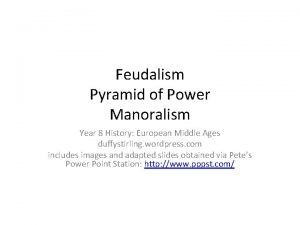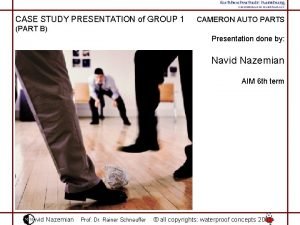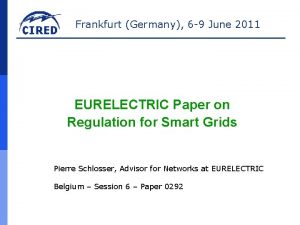POWER CHOICES EURELECTRIC Study on lowCO 2 Europe





















- Slides: 21

POWER CHOICES EURELECTRIC Study on low-CO 2 Europe by 2050 Owen WILSON Environment and Sustainable Development Committee, EURELECTRIC Geneva, 13 th April 2010

Background • EURELECTRIC “Role of Electricity” Study (2007) – Changed Energy landscape • Climate Challenge; Security of supply; Competitive EU economy – Partners: University of Leuven (Demand); VGB (Supply); Technical University of Athens (Modelling); Mc. Kinsey (coordination) – Focus: How to provide low-carbon, secure energy at least cost – Outcome: 50% reduction in EU 27 GHG emissions by 2050 • European Council decisions on Climate-Energy package and 2050 objective • Economic and financial crises • Electricity industry CEOs Declaration

EURELECTRIC CEO Declaration 18 March 2009 Carbon-neutral power in Europe by 2050 1. Cost-efficient, reliable supply through an integrated market 2. Energy efficiency & electricity use as solutions to mitigate climate change

High Level Strategy to deliver CEO Declaration • Build on “Role of Electricity” Study – “Role of Electricity” took technological and policy developments as start point and projected impacts on CO 2 emissions to 2050 – New study, “Power Choices”, takes 2050 GHG objective (-75% on 1990) as start point and maps most economic pathway for delivery – Consequential impacts on SO 2, NOx emissions also assessed

“Power Choices” Study SCENARIO ASSUMPTIONS • 75% GHG cut across whole EU economy, consistent with 450 ppm global in 2050 • CO 2 price applied uniformly to all sectors BASELINE ASSUMPTIONS • No new policy developments post 2009 • ETS 1. 74% p. a. reduction continues • Power becomes major transport fuel • No CO 2 price in non-ETS sectors • All power generation options available (with CCS commercially available as of 2025) • Bottom up measures to support energy efficiency, new renewables • Major policy push in energy efficiency • No binding RES target post-2020; RES support mechanisms withdrawn by 2030 • CO 2 price is the only driver for low-carbon generation post 2030 • Rational behaviour by economic agents MODELLING • PROMETHEUS to evaluate global energy supply/demand prices • PRIMES to evaluate EU 27 energy supply/demand (as per DGTREN Dec 2009) and emissions

“Power Choices” Output Summary • Energy efficiency in buildings, houses, electricity use (appliances, lighting, heat pumps, motor drives … ) – Domestic sector savings • -16% in 2030 relative to Baseline; -39% in 2050 relative to Baseline – Electrification of road transport • 10% in 2030; 80% in 2050 • Renewables in heat and power generation – 37% in 2030; 40% in 2050 • CCS in power generation – 63 GW in 2030; 191 GW in 2050 (85% of CO 2 captured) • Nuclear energy – 132 GW in 2030 (85 GW new); 175 GW in 2050

Energy Efficiency is Key Stationary uses - 10% on Baseline by 2030 - 30% on Baseline by 2050 Transport uses - 7% on Baseline by 2030 - 29% on Baseline by 2050

Composition of electricity demand Electricity demand on Power Choices vs. Baseline

Overall energy demand -30% vs. Baseline in 2050 Mtoe Final energy consumption by sector, EU-27 1400 1200 1000 Heavy Industry 800 Other Industries Tertiary 600 Residential Transport 400 200 0 Paradigm shift to 2010 efficient 1990 1995 2000 2005 2015 2020 2025 electric 2030 2035 2040 technologies 2045 2050 More electricity = less energy

Need for all low-carbon generation options In 2050 RES: • 40% of total mix (1910 TWh) • Wind: 56% of RES Nuclear: • 28% of total mix (1330 TWh) CCS: • 28% of total mix (1320 TWh) Other fossils: • 4% of total mix (210 TWh) Net power generation in EU-27

Carbon emissions from power fall by >90% Deep emission cuts take place between 2025 -2040. But investments are needed NOW! NOW: 1423 Mt. CO 2 2050: 128 Mt. CO 2

Decomposition of emissions reduction in Power Sector

Decomposition (ex-post) of emissions reduction

Investment needed across the period Gross investment in generation capacity MW 2010 – 2050 13% 17% 4% 52% 14%

Significant investments… … but a reasonable cost for society Investment needed in power generation by 2050: € 2 trillion

What if… Nuclear phaseout is reversed in Germany and Belgium? Commercial deployment of CCS is delayed to 2035? One-third of onshore wind power is not built due to planning problems?

All technologies are really needed CO 2 emissions from power, EU-27 Mt CCS delay 1600 Power Choices Nuclear+ • More nuclear = more rapid reduction curve 1400 • 10 -year delay of CCS = delayed CO 2 emission reductions from power & whole economy! 1200 1000 800 600 400 2005 2010 2015 2020 2025 2030 2035 2040 2045 2050 • 1/3 onshore wind not built = more CCS & nuclear, off-shore wind not likely to fill gap.

Power Sector SO 2 and NOx emissions SO 2 emissions • 3. 3 Mt in 2000 • 0. 2 Mt in 2050 NOx emissions • 1. 6 Mt in 2000 • 0. 5 Mt in 2050 Major impact on urban air quality

Key outcomes EU carbon-neutral power by 2050 is realistic -75% GHG on whole economy can be reached • Energy efficiency is critical – • • • Electrification of the demand side essential All power generation options needed Significant investment but at acceptable cost to society The major CO 2 reductions in power are achieved from 2025 onwards CCS delayed &/or nuclear phase-out = slower CO 2 reduction Significant co-benefits with air pollutants

Policy recommendations CO 2 reductions • Support CO 2 market to deliver cap at least cost • All sectors to internalise cost of GHGs • Promote an international agreement on climate Cost • Significant investment cost but reduction in share of GDP • Recognise that cost of technology deployment differs substantially across the EU Technology choices • Enable the use of all low-carbon options for power generation • Encourage public support for modern energy infrastructure: onshore wind, CCS, smart grids… Demand-side • Major policy push in energy efficiency • Facilitate electrification of road transport and spatial heating & cooling

EURELECTRIC’s partner organisations in Power Choices study: National Technical University of Athens Verband der Großkraftwerks-Betreiber
 Power traiangle
Power traiangle The study of choices
The study of choices Feudal pyramid of power
Feudal pyramid of power Case series
Case series Retrospective cohort study
Retrospective cohort study Process of method study
Process of method study Marty lobdell
Marty lobdell Phytogeographical regions of india by d chatterjee
Phytogeographical regions of india by d chatterjee Objectives of work study
Objectives of work study Differentiate between time study and motion study
Differentiate between time study and motion study Observed power spss
Observed power spss Cameron auto
Cameron auto Patterns of power study guide
Patterns of power study guide Severn tidal power feasibility study
Severn tidal power feasibility study Solar power satellites and microwave power transmission
Solar power satellites and microwave power transmission Actual power
Actual power Flex power power supply
Flex power power supply The dispersive power of grating is
The dispersive power of grating is Power of a power property
Power of a power property General power rule
General power rule Power angle curve in power system stability
Power angle curve in power system stability Informsu
Informsu









































